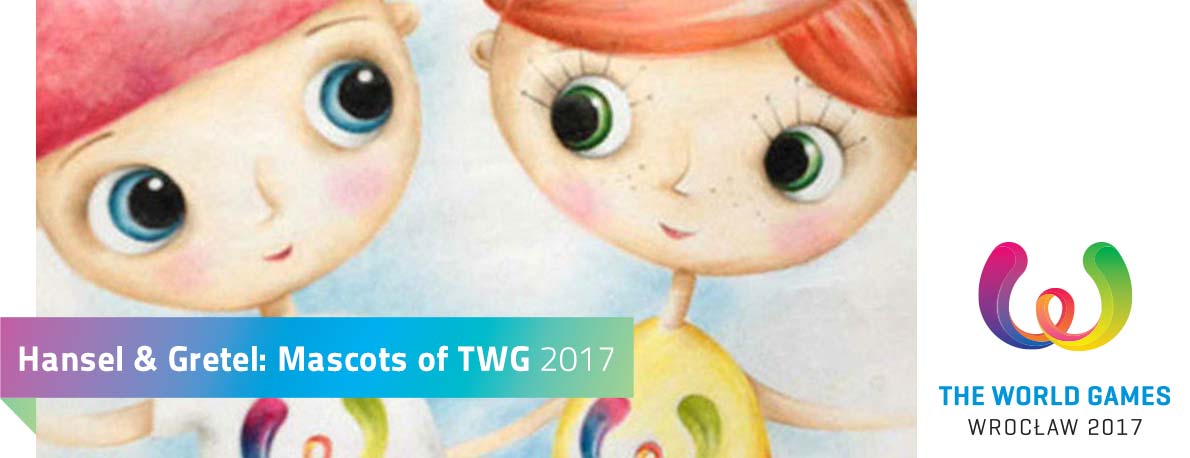Mascots: Cheerleaders of The World Games
Mascots in The World Games have become the “cheerleaders” of the event. They walk around, encouraging the spectators to cheer on the competitors, and animating the crowd. Mascots are also great ambassadors for the host city and the event. The small doll-like figures are much appreciated souvenirs and mementos of the various editions of The World Games.
Not all editions of The World Games have had a mascot. In 1989, Karlsruhe in Germany was the first Host City to introduce a mascot. Though the mascot of TWG1989 was printed on all publications of the event, it was not a real one, as we know it today. The Karlsruhe figure was just a graphic design, not a three dimensional creature, that could walk around and inspire the public. It was not even given a name. It was a peacock, and it was chosen for its colorful fan-shaped tail, because the structure of Karlsruhe is also fan-shaped, all avenues radiating like sunrays out from the city centre. Though the mascot was not given a name, it showed the city’s motto “Fidelitas” prominently on its belly.

The next host city that created a mascot for The World Games was Lahti, Finland for TWG1997. Osmo Penna, the designer of the mascot, felt that a fox with its playful spirits would be a good choice. The fox is athletic enough to perform all The World Games sports. This was necessary, as the mascot was also used as pictogram for the participating sports. To give the fox a Finnish look, the designer gave the mascot the four-cornered hat from Lapland. A local teacher proposed the name August for the mascot. The name not only resembles the month in which the event was held, but August(e) is also the name of the funny clown at the theatre and circus.
From TWG1997 onwards, all editions of The World Games have had a real mascot. The World Games in Akita, Japan, in 2001 even had a twin mascot (an example later followed by Kaohsiung). The peacock and fox mascots had been recognizable animals. The twin mascots Huggy and Nummy of Akita, however were entirely fantasy creatures. The egg-shaped creations were hairy and had fur. To show that Nummy was of the female gender, she had a ponytail on top. Huggy showed The World Games logo on his chest, while Nummy displayed the Akita event logo. Both were very sporting and athletic, as their pictures were used in the pictograms of the participating sports.
The organizers of TWG2015 in Duisburg, Germany also chose to create a fictional mascot. It is very difficult to find any likeness in the Duisburg mascot to a living creature, though it had arms and legs and could walk. Its name was very well chosen for a sporting event; “Allwin”. This name is very much like the German boy’s name “Alwin”, but through the slight change in spelling, it was also the slogan for the games, indicating that “all win” in this event
In the footsteps of Akita, Kaohsiung created twins as mascots for TWG 2009. The mascots were used, las in previous editions, for the pictograms of the participating sports. The doll-like mascots Gao Mei and Syong Ge were named after the two syllables of the city’s name, Kaoh-siung (according to the pronunciation of the name of the City “Kaoh=Gao” and “siung=Syong”). The mascots were intended to personify Kaohsiung as “a city of the sea and the sun” and to symbolize the “friendliness and hospitality” of the city’s residents.
The mascot of TWG 2013 was not a creation of fantasy and fiction, but was modeled on real existing bird. Its official name is “Pitangus sulphuratus” or in plain English the Great Kiskadee. In the Spanish language, its name is a different story; almost every country in Latin America has a different name for the bird. In Cali, Colombia the name of the bird is Bichofué. The mascot Bichofué was a nicely colored creation, which worked well as a “cheerleader”, firing up the enthusiastic crowds at the sports competitions in Cali.
At the various World Games editions, organizers involved the kids in town and in the schools, to create posters and other drawings, which were used for the publicity and promotion of the event.

The organizers of TWG2017 in Wroclaw, Poland are the first to involve the youth and the schools directly in the design and creation of the mascot for TWG 2017. From the 620 proposals and designs submitted by children, the jury made a final selection of five designs. These five designs - the Bee, the Lion, the twins Hansel and Gretel, the Dwarf and the Owl-Cat, were published on the website of the World Games. The final selection of “Hansel and Gretel” was done by internet voting.
So the winners of the contest are the twins “Hansel and Gretel”. Wroclaw has followed the example of Akita and Kaohsiung by selecting a twin mascot. This time, the mascot twins are figures from the well-known fairy tale of Hansel and Gretel. The TWG2017 mascots will be full size models, shaped on the basis of the winning design of “Hansel and Gretel”.

